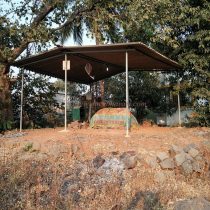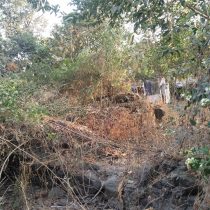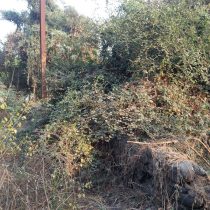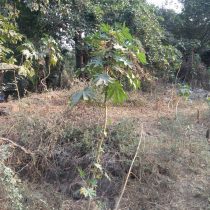KAMBE KOT
TYPE : COASTAL FORT
DISTRICT : THANE
HEIGHT : 0
GRADE : EASY
Kalyan was an important port in ancient times. Ships used to travel from the Arabian Sea through the Gulf of Ulhas. Ghodbunder and Naglabandar were ancient ports on this waterway. To protect these ports and waterways, four forts namely Ghodbunder, Naglabandar, Gomukh and Ovale Kot were built in the south of Ulhas Bay, while small forts Nagle, Kharbav, Firangkot, Kambe fort were built in the north of Ulhas Bay. Seeing the increasing movement of the Maratha army along the Kalyan Bay, the Portuguese built this fort on a small hill top at Kambe village on the banks of the Kamwari Bay for the purpose of guarding and protecting the Kamwari River. Along with Kambe, he tried to strengthen their control by building forts like Kharbav, Pimplas, and Firangkot. The Portuguese may have used this strategy to counter the Maratha arsenal of international trade and warships.
...
To go to Kambe fort one can go to Firangkot by seeing Kharbav fort on Vasai-Chinchoti-Anjurphata-Bhiwandi route and from there one can go to Kambe Fort or reach Kambe village 8 km via Bhiwandi. Kambe fort is situated on a small bushy hill of 50 feet height and the locals do not know anything about this Fort as a fort. When asked about Fort the location of “Pir”, the locals tell the correct place. This “Pir” place is located inside Fort. Before going there, go with full information about this fort. Only ruins of this fort built by the Portuguese are left now. Kambe fort was roughly rectangular in shape and today only the foundations of the ramparts, some porches of the building and the foundations of two bastions in the ramparts remain. This monument which is a witness of history has been almost demolished today. As the fort is used as a dustbin and toilet, there is a stench and dirt inside. Travel inside Fort has to be done very cautiously. There is no scope to know whether this was a defense facility or not due to the extensive collapse of the Fort. Carved stone, cement, lime are used in the construction of this Fort. Given the available remains and historical context as well as the size of this fort, this fort may have been used as an administrative office, as well as a tribute and surveillance station during the Portuguese period. The fort is small and can be seen in ten minutes. Although the fort is not fully extant today, its precise geographical location and strategic position to guard the Kamwari River can be seen. Using small-sized forts, watchtowers, the Portuguese established their empire on the sea route of North Konkan. Built by the Portuguese around the 16th century, the main purpose of these lookout forts was to protect waterways and provide necessary logistics to small and large forts in the province. It is recorded that the Marathas under the leadership of Pilaji Jadhav conquered Kambe Fort in 1730 AD. At this time 8 Portuguese officers, 1600 soldiers were captured. Later, in the Maratha-Portuguese treaty, this fort again came under the control of the Portuguese. In this Vasai campaign of AD 1739, the area of Kharbav, Kambe, and Firangipada came under the control of the Marathas and the Portuguese were evicted from this area forever. A person who comes here with expectation of seeing the fort is likely to be disappointed, but if you want to see the Portuguese watch post on the sea trade route and its geographical importance, you must visit this place. These forts, which have played a significant role in history, should be preserved today, otherwise the coming generations will only be able to witness these places in pages of history.
© Suresh Nimbalkar





